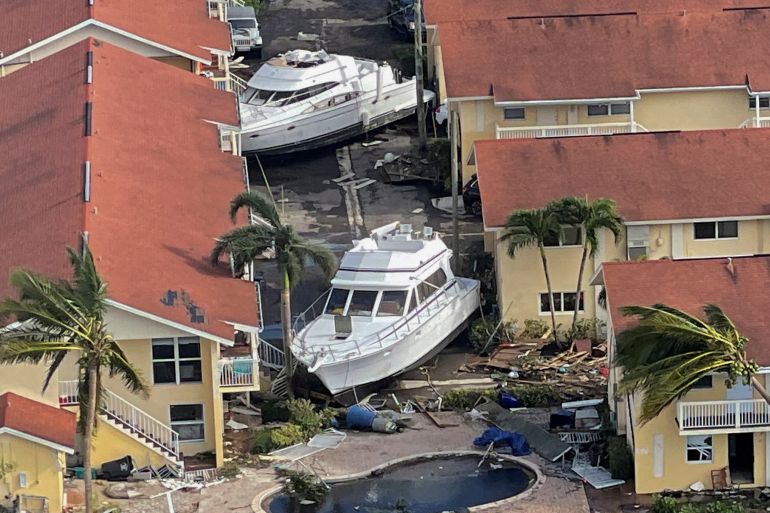Biden warns of ‘substantial’ deaths as Florida reels from storm
US authorities say the full extent of the damage from Hurricane Ian’s strong winds and flooding is not yet known.

US President Joe Biden has warned that Hurricane Ian could be the deadliest storm to hit Florida in the state’s history, as rescue teams raced to save residents trapped by floodwaters, fallen electricity lines and debris.
Biden on Thursday promised that the federal government would do everything it could to get Florida residents the support they need after the storm, which made landfall a day earlier as an “extremely dangerous” Category 4 hurricane.
Keep reading
list of 3 itemsPhotos: Hurricane Ian knocks out power lines in Cuba
Where is Hurricane Ian now headed and how to prepare for it?
“This could be the deadliest hurricane in Florida’s history,” Biden said during a visit to Federal Emergency Management Agency (FEMA) headquarters in Washington, DC. “The numbers are still unclear but we’re hearing early reports of what may be substantial loss of life.”
One of the strongest storms to hit the United States in years, Hurricane Ian has cut a path of destruction across Florida, with floods trapping people in homes and power knocked out for more than 2.6 million homes and businesses.
Authorities have only begun to assess the damage, as power outages and a lack of mobile service early on Thursday made it nearly impossible for many people to call for help from the hardest-hit coastal areas on the state’s Gulf coast, where the hurricane made landfall.
Authorities confirmed at least one death in Florida – that of a 72-year-old man in Deltona who fell into a canal while using a hose to drain his pool in the heavy rain, the Volusia County Sheriff’s Office said.
A boat carrying Cuban migrants sank on Wednesday in stormy weather east of Key West. Rescuers were able to save nine people, an official said on Thursday, but more than a dozen others remained missing as the search continued.
The storm has transformed Florida’s southwestern shoreline – an area dotted with sandy beaches, coastal towns and mobile home parks – into a disaster zone as Ian swept seawater into waterfront homes.
“Sanibel Island is destruction … it got hit with really biblical storm surge. It washed away roads. It washed away structures,” Governor Ron DeSantis said during a news briefing as he described the widespread damage.
DeSantis said earlier that 28 helicopters were performing water rescues and that the bridge to the island was severely damaged and impassible. “There have been a number of people identified and brought off the island safely and those efforts are ongoing,” he said.
#Update: A total of 9 Cuban migrants associated with this event have been safely located & rescued. @USCGSoutheast search and rescue operations remain ongoing.
— Chief Patrol Agent Walter N. Slosar (@USBPChiefMIP) September 29, 2022
Biden approved a disaster declaration on Thursday, making federal resources available to the counties affected by Ian.
But an unspecified number of people were stranded in high-risk areas of Florida after choosing to ride out the storm at home rather than heed evacuation orders, and they were beyond the immediate reach of rescue crews, DeSantis told reporters.
“The Coast Guard had people who were in their attics and got saved off their rooftops,” he said.
“We’ve never seen storm surge of this magnitude … The amount of water that’s been rising, and will likely continue to rise today even as the storm is passing, is basically a 500-year flooding event.”
In Collier County, which includes the coastal city of Naples, the sheriff’s office said portable towers were being installed to provide mobile service. “We can tell you as daylight reveals the aftermath, it’s going to be a hard day,” the office posted on its Facebook page.
In neighbouring Lee County, which includes the city of Fort Myers, Sheriff Carmine Marceno said many residents were “without power and unable to communicate”.
In a Facebook post, he said officers could be dispatched to check on loved ones if they are able to access the affected areas. Law enforcement officials in Fort Myers said they received several calls from people trapped in flooded homes or from worried relatives.
“A lot of down trees, a lot of flooding everywhere. We are trying to get a hold of my daughter,” said Terri Byrd in a vehicle in a Walmart parking lot, trying to get cell service after spending the night at an elementary school in Venice, Florida.
Across the region, officials and residents spent the morning assessing the damage.
In Punta Gorda, a town directly in the hurricane’s path, trees, debris and power lines covered roadways, though many buildings remained standing, having withstood the storm’s onslaught better than many had feared.
“It was insane,” said local landscaper Jeffrey Chambers, 53, noting the storm brought sideways rains and white-out conditions. “I was like ‘Please stop already, just stop.’ And it kept going and going.”
In its most recent update at 5pm local time (21:00 GMT) on Thursday, the US National Hurricane Center (NHC) classified Ian as a hurricane again after downgrading it to a tropical storm earlier. It warned of “life-threatening flooding, storm surge and strong wind” in Georgia, South Carolina and North Carolina.
Ian had packed Category 4 strength when it first hit Florida with 241km/h (150mph) winds, tying for the fifth-strongest hurricane, when measured by wind speed, ever to strike the US.
The hurricane slammed Cuba on Tuesday, killing two people and bringing down the country’s electrical grid. The island slowly began to restore power on Thursday.